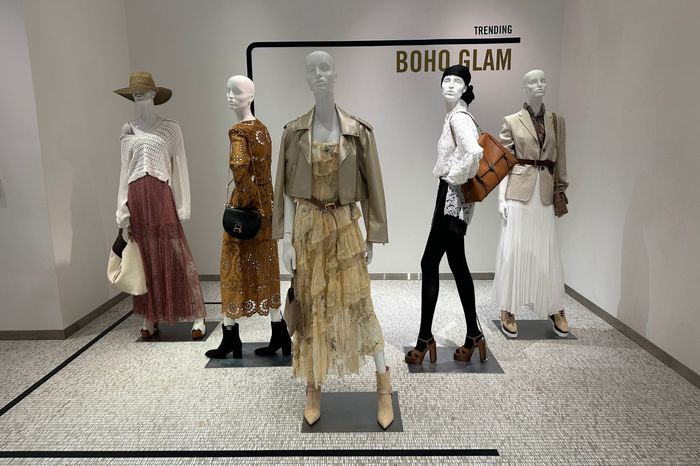Why I am tired of the trend predictions trend
Elodie Matthews argues that originality is in and fashion predictions are out for 2025

What is ‘in’ this year? This is the ultimate question facing us every January in the quest for cool girl reinvention. And where better to find the answers than the fashion bible that is TikTok?
A TikTok search, or local Sidge girlie if you’ve matured past the app, will immediately tell you 2025’s ‘ins’ with a regurgitation of “polka dots, buttons, fun tights, Isabel Marant, fisherman, sequins, the return of heroin chic Kate Moss model skinny”, or words to that effect. In short: the micro trend; the aesthetic.
Despite everyone’s mutual disdain for the micro trend and fast fashion cycle, we are seemingly trapped in its perpetual grip. Arguably, this makes some sense. In a capitalist world of hyper-exposure to short form fashion content, our rate of consumption, and simultaneously the trend cycle, has accelerated. Traditionally, trends organically trickled down from designers, or consumers sought out less explicit dictations of inspiration. Fashion was an arena for a diversity of sociocultural influences to be embodied.
“In a capitalist world of hyper-exposure to short form fashion content, our rate of consumption, and simultaneously the trend cycle, has accelerated.”
Fashion has always carried a culture of subversion. It’s an artform which is not only relatively accessible, but fun to play with. Designers and consumers alike have sought to beat the trend cycle, to make something previously seen as ugly beautiful. There is real art and creativity in this process. It allows for our clothes to become more than material, and for the body to display identity, personhood, a symbol of the role of the self against rigid preferences of wider society.
Within the trend cycle, these subversions catch on, become ‘cool’, then mainstream, then basic, then dated. The fate of those items labelled next year’s hottest trends (which, let’s be honest, are already trendy) is likely tragic. Their destiny is to end up on your ‘For You Page’ next January as a 2026 ‘out’. This rapid rise and fall of items we explicitly call ‘cool’ is notably demonstrated with the journey of leopard print over the past year.
A few years ago, the pattern carried an association with poor taste (largely class affiliated). Its subversion saw it rise in popularity, especially alongside the ‘mob wife aesthetic’ at the start of last year. Leopard quickly became a staple. Just as quickly, it has now become dated. Fast fashion brands such as Zara and Shein caught on, it became too accessible, it became boring. The element of creativity, of subversion, of art was lacking. There is an argument here that a direct correlation exists between wealth and cool. This is largely due to the purchasing power of the wealthy and their ability to intercept trends in the early, expensive stages before fast fashion brands mass distribute a cheaper version. However, despite the strong correlations, I am a firm believer that an ability to overconsume does not make you a ‘cooler’ person.
The environmental impacts of overconsumption and fast fashion cycles are well known. We can literally see influencers, overconsumption, and wealth burning in the LA wildfires, and the simultaneous sense of irony and tragedy is not lost. We see the ‘cool girl’ gospels burning. We can recognise the danger of the fast fashion cycle. Yet we continue to feed it, to buy into the prescribed notions of what is and isn’t ‘cool’. We see an image of ease, of effortless cool – think the Gone Girl monologue – accessible through consumption, and we want it, whatever the cost. Cool girl status is apparently worth more to us than our planet.
“Even charity shopping can be understood as a trend, aestheticised by social media.”
It is true that charity and vintage shopping is also ‘in’, brilliant! However, even charity shopping can be understood as a trend, aestheticised by social media. When performed in the context of the search for the aesthetic, it too easily slips into a cheaper way of facilitating continual consumption. Albeit, second-hand clothes do remain a more ethical choice than newly bought fast fashion items.
Significant environmental concerns aside, trend prediction TikToks are also boring. We lose the authenticity and fun in subversive expression when a singular item or aesthetic is preached as ‘cool girl’. The roots of fashion are in self-expression, exploration and creativity. Second-hand and charity shopping can be much more fulfilling and sustainable when accessed in considered moderation, a source of potential inspiration and personal innovations.
My plea, rather than prediction, for 2025 is for a rejection of the urge to overconsume in favour of an organic, creative relationship with your wardrobe. The age-old ‘wear what makes you feel good’. But seriously, rediscover the personalisation, creativity and fun that comes from authentic dress-up. I promise you don’t need TikTok, or Varsity, to tell you what’s cool.
Want to share your thoughts on this article? Send us a letter to letters@varsity.co.uk or by using this form
 News / Caius mourns its tree-mendous loss23 December 2025
News / Caius mourns its tree-mendous loss23 December 2025 News / Cambridge welcomes UK rejoining the Erasmus scheme20 December 2025
News / Cambridge welcomes UK rejoining the Erasmus scheme20 December 2025 News / CUP announces funding scheme for under-represented academics19 December 2025
News / CUP announces funding scheme for under-represented academics19 December 2025 News / King appoints Peterhouse chaplain to Westminster Abbey22 December 2025
News / King appoints Peterhouse chaplain to Westminster Abbey22 December 2025 Interviews / Politics, your own way: Tilly Middlehurst on speaking out21 December 2025
Interviews / Politics, your own way: Tilly Middlehurst on speaking out21 December 2025








